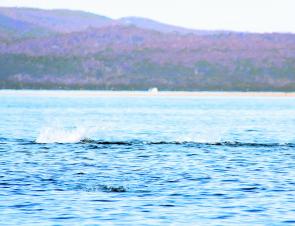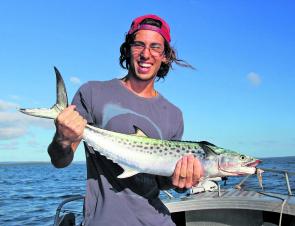What a long summer we have had this year! It started earlier than normal and has finished later than expected. We have had days over 30ºC consistently, even as late as mid-April, and this has been reflected in the fishing.
Normally at this time of year we see the start of the winter snapper run, but at the time of writing this hasn’t started just yet. I put this down to the hot weather we’ve been having, which has been keeping water temperatures slightly higher than normal for this time of year.
This doesn’t mean that there aren’t any snapper in the bay; they are there all year round. It just means that they have not yet started schooling up to begin their winter breeding cycle. When it comes to snapper fishing, over the last month the northern islands have been a bit inconsistent. If you’re after a feed I would look around Macleay and Coochie, because at this time of the year the fish tend to move down to those southern islands. It happens every year where the northern islands go quiet for a month or so but the bottom islands really fire, and with some great quality snapper too.
There are positives to the water/air temperatures staying above average for this time of year and that is that we have an extended pelagic season. It is normal for the longtails to hang around for all of April and a little bit of May but the surprise for me has been the big numbers of spotted mackerel that have still been around. Both the longtails and the spotties have been feeding on football field sized schools of whitebait and small pilchards. Spotties are an awesome fish to chase on light gear.
When tuna and mackerel are feeding in the same areas and you are targeting one or the other, it is important to be able to tell the difference between their feeding styles. That way, you’ll be able to separate the schools of tuna and the schools of spotties.
When looking at a school of tuna they can feed two ways. The first is when they are in a feeding frenzy. You will see them hitting the surface really aggressively, and it almost looks as though a little bomb is going off. They tend to feed this way when they are feeding in a pack, and they all use each other to herd the bait up and then go in for the kill.
The second way in which they feed is when they ‘porpoise’. They do this when there are only a couple of fish in an area, or when there are plenty of them but they’re all spread out and not in feeding in packs.
If you are looking at a school of mackerel you will see that they to school the bait up nice and tight before they slice through them. They do this because it is easier to aim for a mass of fish and not just a couple of fish. Mackerel, unlike tuna, are always aggressive when feeding. However, because of their body shape they slice through the surface rather than explode through the surface like a tuna.
That’s what’s happening above the water, but that’s only the half of it! When you are looking for pelagic species like mackerel and tuna, the easiest way to spot fish is to look for birds. When birds fly over a tuna school they dive into the water to get the baitfish. When they are over a school of mackerel, they dive down to the surface of the water then only stick their beaks into the water before flying to a safe height. They apparently know that mackerel teeth are razor sharp. A feeding mack could easily bite off a webbed foot, a wing or even a whole bird.
I hope this insight into the differences between mackerel and tuna helps you when targeting these speedsters, both of which are great fun and very tasty. Now get out there and put it into practice!
Reads: 3427
This is a prime example of a tuna exploding on a bait school.

Josh Pirrotta with his first ever mackerel. Mackerel fishing is great for new anglers – it’s visual and the fish pull hard for their size as well.

There is no better sight then seeing baitfish showering through the air and mackerel slicing through the bait ball.




